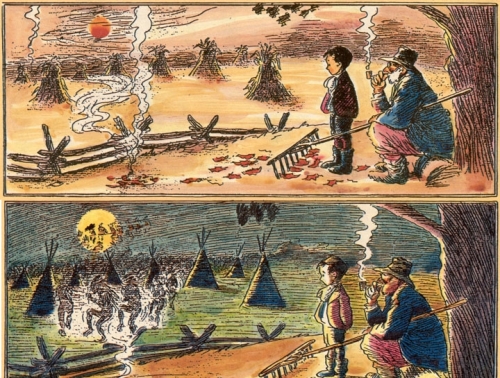
Not really the comics.....but "Injun Summer"was a mainstay from my youth as a paperboy.
I know it was time to find the gloves and hat when this was published.
The famous cartoon first appeared on Sept. 30, 1907, on Page One, the answer to a looming deadline on a slow news day. John T. McCutcheon, inspired by a string of beautiful, warm autumn days and remembering his youth in Indiana, conjured up the illustration that became one of the most popular features in Tribune history.
The Tribune reprinted it in 1910, on page 4, in response to readers' requests, and then annually this time of year from 1912 to 1992. As early as 1919, the "famous" cartoon had become a "much-loved" annual event, the Tribune said in promoting a high-quality print — "ready for framing" — that the newspaper included in an upcoming Sunday edition. The cartoon wouldn't be contained to its annual appearance on newsprint.
The Indiana State Fair reproduced it as a feature exhibit in 1928. At the Century of Progress World's Fair in 1933-34 it was a life-size diorama and was reproduced in a fireworks display. In 1920, the Indiana Society of Chicago presented a dramatized version of the work to honor McCutcheon. His son, John Jr., a future Tribune editorial page editor, played the boy. Neighborhood, school and social groups acted out "Injun Summer" scores of times, as recently as 1977. One of the biggest dramatizations involved 1,100 children performing it at Soldier Field in August 1941 as part of the Tribune-sponsored Chicagoland Music Festival.
A very popular display with mannequins appeared every year at the Olson Rug Co.'s park on the Northwest Side. McCutcheon's original black-and-white drawing is in the collection of the Chicago History Museum. Over time the cartoon came to evoke anger as well as nostalgia. As early as 1970, readers wrote letters complaining that the Tribune was running an ethnically insensitive feature that misrepresented the brutal reality of Native American history in the United States in the 18th and 19th centuries. Letter writers also were unhappy with the idea that "they ain't no more left," pointing out that Indians still lived and worked in Chicago. In the 1990s, Tribune editors decided to end the annual tradition. Douglas Kneeland, the Tribune's public editor at the time, said, "'Injun Summer' is out of joint with its times. It is literally a museum piece, a relic of another age. The farther we get from 1907, the less meaning it has for the current generation." Still, the cartoon has a powerful hold over many Chicagoans. For generations of readers, "Injun Summer," despite its flaws, became synonymous with the magic and peacefulness of those last warm days of the season.
Marty
Nashville, TN
No comments:
Post a Comment